
H310 LOADER
Loader
- Superior strength and visibility
- For heavy-duty chores
- Parking stands are integrated on the loader
View Product Brochure
Features
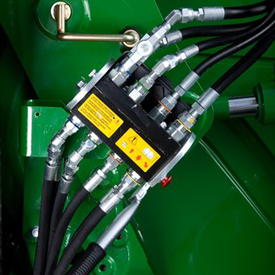 Single-point hydraulic connection on row-crop tractor (closed)
Single-point hydraulic connection on row-crop tractor (closed)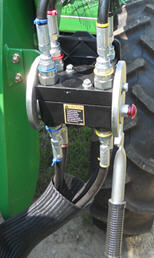 Single-point hydraulic connection on utility tractor (closed)
Single-point hydraulic connection on utility tractor (closed)The 520M, 540M, H240, H260, and H310 Loaders can be ordered with a single-point hydraulic connection that also incorporates the connection point for any electrical needs. To disconnect the hydraulic connection between the loader and the tractor, it is necessary to relieve the hydraulic system oil pressure on the tractor.
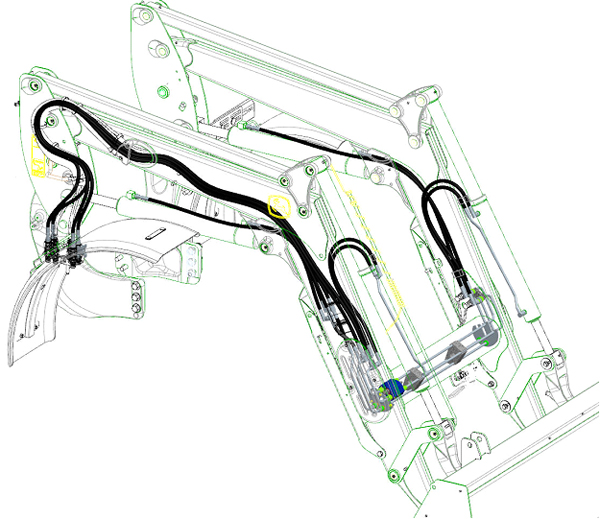 Concealed oil lines through boom arm
Concealed oil lines through boom arm
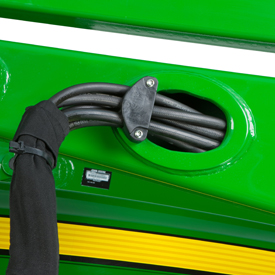 Oil lines routed through the boom arm
Oil lines routed through the boom arm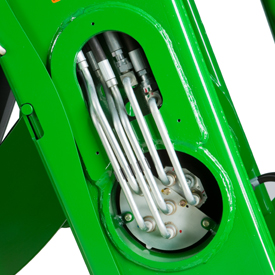 Oil lines routed through the torque tube
Oil lines routed through the torque tubeOver time, increased width in tractor hoods have caused issues with available space for running traditional oil lines of a loader along the boom, making them more susceptible to damage.
To improve this situation, the oil lines have been routed through the boom arm and the torque tube, improving line protection and the appearance of the loader.
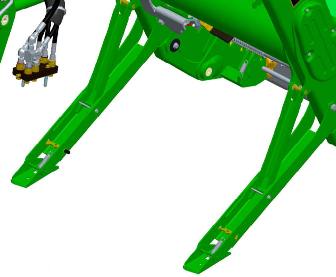 Parking stands
Parking stands
John Deere loaders are easily removed and reinstalled on tractors without tools. The parking system allows removing or attaching the loader to the tractor in minutes without the need for tools.
To remove or park the loader, apply slight down pressure to the loader boom with the bucket dumped at approximately a 30-degree angle. With the tractor in park, lower the parking stands and place the mast pins in the open position.
Removing or parking the loader
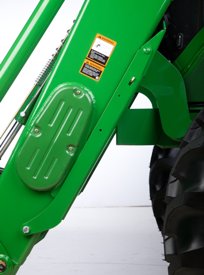 Parking stand in stored position
Parking stand in stored position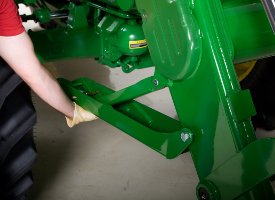 Removing parking stand
Removing parking stand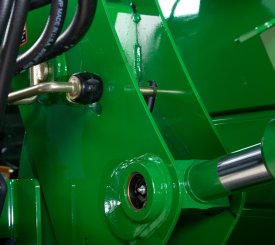 Mast pin in the closed position
Mast pin in the closed position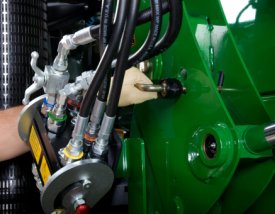 Rotating mast pin to the open position
Rotating mast pin to the open positionUtilizing the boom circuit with the tractor in neutral, rotate the mast forward until the mast has rotated past the pin location on the mounting frame by extending the lift cylinder. Now using the bucket circuit, roll back the bucket until the mast is removed from the pocket and will clear the tires.
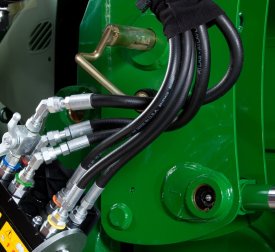 Mast pin in the open position
Mast pin in the open position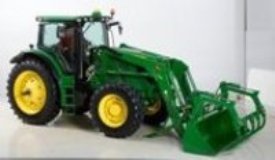 Masts rotate forward, then bucket rolled back
Masts rotate forward, then bucket rolled backWith the tractor in park, shut the engine off and relieve the hydraulic pressure as indicated for the tractor (rotating the joystick). Disconnect or open the single-point hydraulic connector (or remove couplers if no single point is installed).
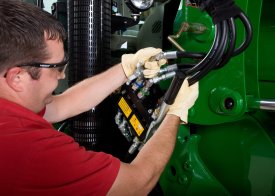 Disconnect/open single-point hydraulic connection
Disconnect/open single-point hydraulic connection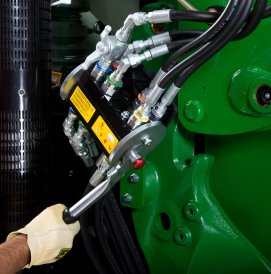 Disconnect/open single-point hydraulic connections
Disconnect/open single-point hydraulic connectionsStore the loader half of the single-point connector or hoses, and back away from the loader.
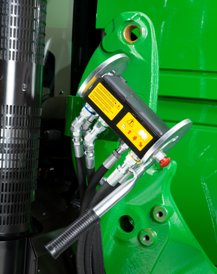 Single-point hydraulics disconnected
Single-point hydraulics disconnected
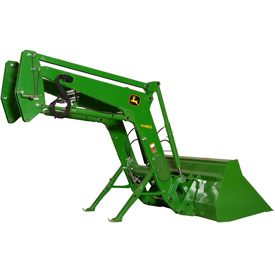 Parked loader
Parked loader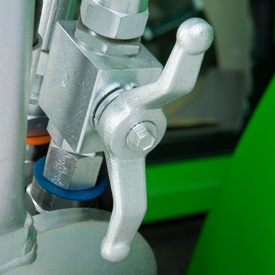 Hydraulic shut-off valve (open position)
Hydraulic shut-off valve (open position)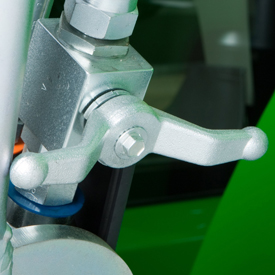 Hydraulic shut-off valve (closed position)
Hydraulic shut-off valve (closed position)A hydraulic shut-off valve is included with the H-Series Ag Loaders to ensure the loader does not lower suddenly. For example, this allows the boom to be locked out when someone is required to be located under the loader boom for service work on the tractor. It should not be used for extended periods of time unless an appropriate support stand is also utilized.
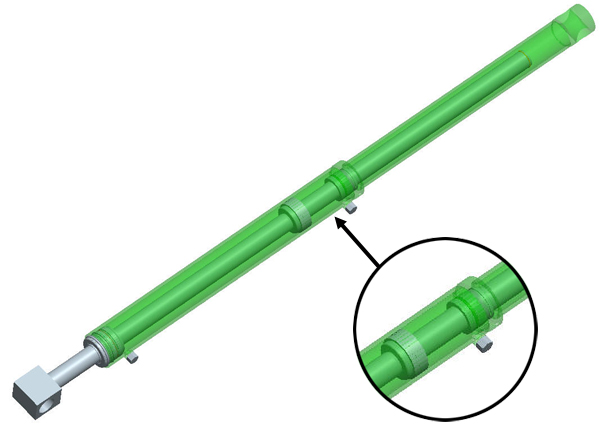 False rod cylinder
False rod cylinder
Fast bucket cycle times are important to dump the load from the bucket as quickly as possible, in order to be as productive as possible, while completing loading operations. The bucket cylinder design can have a major impact on this cycle time, especially for the mechanical self-leveling (MSL) loaders.
Therefore, all MSL M- and H-Series Loaders utilize false rod bucket cylinders. A false rod cylinder has a smaller displacement of oil requirement on the head end of the cylinder, which allows this cylinder to dump much faster than a normal cylinder.
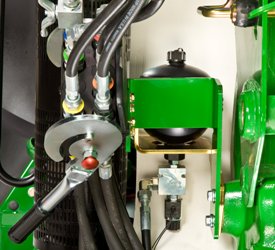 Nitrogen-charged accumulator and electric valve
Nitrogen-charged accumulator and electric valve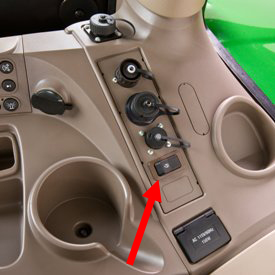 Operator on/off switch
Operator on/off switch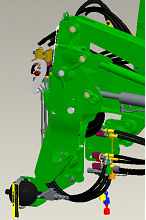 LSS on H180
LSS on H180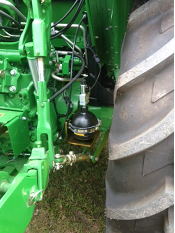 LSS on 5E and 5M
LSS on 5E and 5MAn enhancement to the loader is the suspension system. A great level of loader productivity is achieved with the LSS.
- An accumulator charged with nitrogen and connected to the head-end lift cylinder hose through a T-fitting provides shock absorption
- The cylinders move in and out to allow the boom to float
Performance
- Bales can be transported more efficiently from one end of the field to the other over frozen, hard-packed, or rutted terrain.
NOTE: Check bale-handling capability of tractor before use.
- Pallets can be moved easily without sustaining cargo damage
- Pallets of seed or fertilizer can be carried across a yard without a bag spilling and creating a costly mess
- A properly-ballasted tractor with LSS has increased stability, creating a smoother ride for the operator
Cost of ownership
- Extended life of loader pins and bushings
- Less stress on tractor axle
Reasons for turning LSS off include:
- Digging applications - with LSS on, the cylinders retract slightly, losing lifting power
- Holding a grade when blading - with LSS on, it is difficult to hold a constant grade
- Precise pallet and bale handling - with LSS on, the load moves up and down slightly while being positioned
- Parking a loader - with LSS on, when down pressure is applied, the lift cylinders retract slightly, making it more difficult to park
The switch is conveniently located in the operator station to avoid having to exit the tractor seat to manually move the handle on the LSS.
LSS can also be ordered with a manual shutoff. Depending on the tractor/loader model, the accumulator is located in different places. On the 440R, the accumulator is mounted outside the bottom of the mounting frame. On the 5 Series Tractors, the accumulator is mounted near the inside of the rear right wheel. On 6 Series tractors and larger, it is mounted in between the hydraulic connection and the mounting frame.
Specifications
Compare the specifications of up to 4 models
| Key Specs | h310-loader Current Model |
|---|---|
| Maximum lift height (A) | 3855 mm 151.8 in. |
| Lift capacity at full height | Measured at pivot (U) 3746 lb 1699 kg |
| Boom breakout force | Measured at pivot (Y) 2677 kgf 5902 lbf |
| Bucket rollback force capacity | At ground-level line (ZZ) 3059 kgf 6744 lbf |
| Clearance at full height - bucket dumped (C) | 2826 mm 111.3 in. |
| Dump angle, degrees (E) | -7 degree (angle) |
| Rollback angle, degrees (G) | 42 degree (angle) |
| Tractor | |
| Model | 6105R/6115R/6125R |
| Front tire | 16.9R24 |
| Rear tire | 18.4R38 |
| Front axle configuration | MFWD w/ Limited Slip Differential |
| Wheelbase | 2580 mm 101.6 in. |
| Pump capacity | 114 L/min 30.1 gpm |
| Rated pressure | 2901 psi 200 bar |
| Loader | |
| Base weight | 1356.8 kg |
| Leveling configuration | Mechanical Self Leveling (MSL) |
| Bucket used | Materials 73 in. Materials 1850 mm |
| Bucket weight | 620 lb 281 kg |
| Lift capacity at full height | Measured at pivot (U) 3746 lb 1699 kg Measured at 800 mm ahead of pivot (V) 1846 kg 4070 lb |
| Lift capacity at 59 in. (1500 mm) | Measured at pivot (W) 2187 kg 4822 lb Measured at 800 mm ahead of pivot (X) 2090 kg 4608 lb |
| Boom breakout force | Measured at pivot (Y) 2677 kgf 5902 lbf Measured at 800 mm ahead of pivot (Z) 2335 kgf 5148 lbf |
| Bucket rollback force capacity | At maximum height (VV) 1513 kgf 3336 lbf At 59-in. (1500-mm) lift height (XX) 3003 kgf 6620 lbf At ground-level line (ZZ) 3059 kgf 6744 lbf |
| Dimensions | Maximum lift height (A) 3855 mm 151.8 in. At full height - bucket level(B) 3661 mm 144.1 in. At full height - bucket dumped (C) 2826 mm 111.3 in. |
| Overall length (I+F), ft (m) | 5 m 16.4 ft |
| Overall height in carry position (J) | |
| Digging depth (H) | 31 mm 1.2 in. |
| Reach | At maximum height (D) 800 mm 31.5 in. At ground level - bucket level (F) 2422 mm 95.4 in. |
| Bucket angle | Dump angle, degrees (E) -7 degree (angle) Rollback angle, degrees (G) 42 degree (angle) Dump angle, ground -95 degree (angle) |
| Cycle times | Loader raise, seconds 2.3 seconds Loader lower, seconds 1.9 seconds Bucket dump, seconds 1.4 seconds Bucket rollback, seconds 1.4 seconds |
Accessories and Attachments
Buckets
General Purpose (GP) buckets
- Compatible with digging teeth and replaceable cutting edge
- Not compatible with grapples
- The GP buckets are durable with full length side cutting edges, additional bottom skid plates, and a double reinforced top section
- Holes are drilled in the cutting edge allowing easy attaching of a reversible and replaceable cutting edge
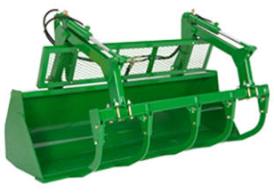 Heavy-duty bucket (shown with grapple)
Heavy-duty bucket (shown with grapple)
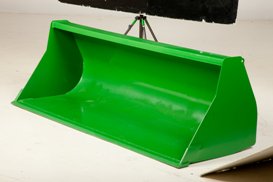 Materials bucket
Materials bucket
Materials buckets may be used for loading dirt, gravel, feed, and light materials as well as scraping, digging, and other general-purpose tasks.
NOTE: Materials buckets are not compatible with replaceable cutting edges or digging teeth.
This general-purpose bucket can be used in numerous applications.
The high-volume bucket is intended for use with lighter-density high-volume materials. The bucket capacity makes this an effective tool for handling snow, wood shavings, and other loose materials.
 Materials bucket
Materials bucket
Materials buckets may be used for loading dirt, gravel, feed, and light materials as well as scraping, digging, and other general-purpose tasks.
NOTE: Materials buckets are not compatible with replaceable cutting edges or digging teeth.
Cutting Edges
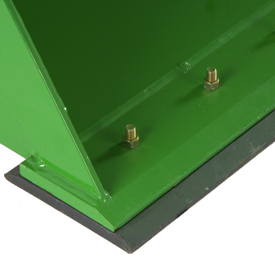 Replaceable wear edge
Replaceable wear edge
For those who frequently scrape on concrete, a replaceable cutting edge will greatly extend the life of the bucket:
- 1850-mm (73-in.) width replaceable cutting edge
- 2150-mm (85-in.) width replaceable cutting edge
- 2450-mm (96-in.) width replaceable cutting edge
- 2750-mm (108-in.) width replaceable cutting edge
Digging teeth can be added to the heavy-duty bucket for easier digging in hard ground or for breaking loose hard-packed materials such as manure or silage. Digging teeth are not compatible with replaceable cutting edges.
EH Valve
E-ICV Valve and Parts (3rd Function) - BW15987
E-ICV Valve and Parts (3rd Function) - BW15988
Mid-Mount E- ICV Valve and Parts (3rd Function) - BW15314
Front Loader Packages
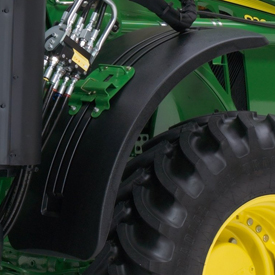 Stationary fender (H480 shown)
Stationary fender (H480 shown)
Loader stationary fenders are highly recommended for those operating in conditions where the front axle will be in full oscillation and turn frequently or where tight turns are made while maneuvering through gates or obstacles that will catch tractor axle-mounted fenders.
The loader stationary fenders still provide coverage for debris from the tire, but they do not protrude to become damaged in operation. The fenders can be removed to enable better access for servicing as well.
Grapples
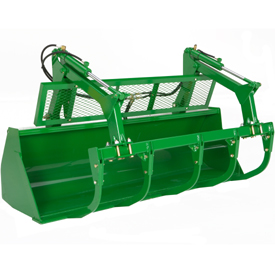 Five-tine round bale/silage grapple with grille
Five-tine round bale/silage grapple with grille
All compatible John Deere Loaders use the same five-tine, pin-on grapple. The advantages of this grapple are:
- The pin-on method puts the least amount of stress possible on the bucket.
- The grapple has a wide stance, making it more difficult to twist.
High-performance operators will choose the five-tine grapple for its increased durability and load-carrying capacity. Advantages include:
- The ability to handle two large round bales instead of one (where loader capacity allows).
- Strong grapple arms allow the bucket capacity to be increased by almost twice the amount of normal bucket capacity in materials such as silage.
The grapple is equipped with twin cylinders to provide excellent clamping force.
NOTE: The center tine of the five-tine grapple is slightly off center to avoid contact with the placement of optional digging teeth.
NOTE: The grapple is not compatible with materials or high-volume buckets.
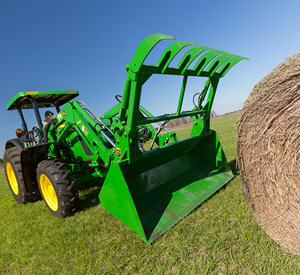 1850-mm (73-in.) bale grapple bucket
1850-mm (73-in.) bale grapple bucket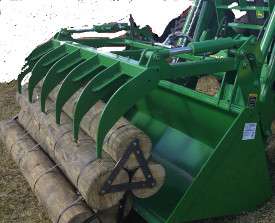 73–in. (1850 mm) grapple bucket BW15358 shown (all one piece
73–in. (1850 mm) grapple bucket BW15358 shown (all one pieceThe bale grapple bucket is a complete solution ideal for full loads of silage, handling bales, or cleaning up debris or manure.
Grapple coupler oil line and bracket - BW16045
Two function
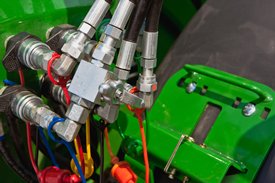 Two function quick coupler
Two function quick coupler
The H240, H260, H310, H340, and H360 Loaders feature two-function quick-couplers in base machine. To disconnect the hydraulic connection between the loader and the tractor, it is necessary to relieve the hydraulic system oil pressure on the tractor.
To watch a video of how to use quick couplers click here.
NOTE: this video is intended to show the functionality of quick couplers only. Location of the connection varies across different loaders.
Three function
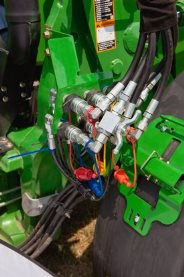 Three function quick coupler
Three function quick couplerThe H240, H260, H310, H340, and H360 Loaders can be equipped with three-function quick-couplers. Hoses will be installed in the boom arm and just the couplers will need to be assembled along with the third-function bracket and oil line. To disconnect the hydraulic connection between the loader and the tractor, it is necessary to relieve the hydraulic system oil pressure on the tractor.
Hood Guards
The hood guard's basic function is to:
- Help protect the tractor grill and hood from falling debris or stationary objects such as a wagon or mixer while loading
- Allow for lighting at night
Compatibility:
- Can be used with or without the tractor front weight bracket but not with the actual front weights while using the loader (this would over load the front axle)
- Cannot be used with a front hitch
It is highly recommended to purchase a front weight bracket when using a loader. The hood guard is designed to be slightly rearward of the front weight bracket. This is so that the front weight bracket is the first point of contact against lower stationary objects.
 Hood guard for 5E Interim Tier 4 (IT4) 4-Cylinder Tractors
Hood guard for 5E Interim Tier 4 (IT4) 4-Cylinder Tractors
The hood guard's basic function is to:
- Help protect the tractor grille and hood from falling debris or stationary objects, such as a wagon or mixer, while loading
- Allow for lighting at night
- Can be used with or without the tractor front weight bracket but not with the actual front weights while using the loader
- Cannot be used with a front hitch
It is highly recommended to purchase a front weight bracket when using a loader. The hood guard is designed to be slightly rearward of the front weight. This is so that the front weight is the first point of contact against lower stationary objects.
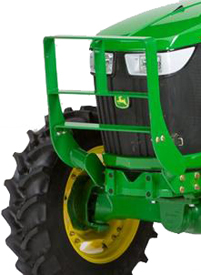 Hood guard for 5M Series Tractors
Hood guard for 5M Series Tractors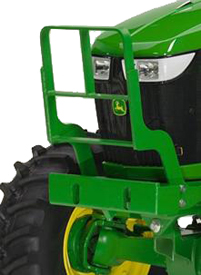 Hood guard for 6D Series Tractors
Hood guard for 6D Series TractorsThe heavy-duty hood guard is compatible with 5M (5065M, 5075M, 5085M, 5095M, 5100M, 5105M, and 5115M), 6D – model year 2012 and prior (6100D, 6115D, 6130D, and 6140D), 6D – Interim Tier 4 (IT4) model years 2013 -2015 (6105D, 6115D, 6130D, and 6140D), and 6E Final Tier 4 (FT4) model year 2016 (6105E, 6120E, and 6135E) Tractors.
The basic function of a hood guard is to:
- Help protect the tractor grille and hood from falling debris or stationary objects such as a wagon or mixer
- Allow for lighting at night
The hood guard:
- Can be used with or without the tractor front weight bracket but not with the actual front weights while using the loader (this would overload the front axle)
- For the 5M Series Tractors, the bottom bar must be removed for usage with front hitch for storage position of the center link.
It is highly recommended to purchase a front weight bracket when using a loader. The hood guard is designed to be slightly rearward of the front weight bracket. This is so the front weight bracket is the first point of contact against lower stationary objects.
If a front weight bracket is not used, the lower bar can be moved downward to improve the protection of the grille below the lights.
The features of the hood guard include:
- Folds down to allow the hood to open and provide access to the battery and filter
- Extra steel behind the mainframe to increase strength
- High height to better protect the top of the hood
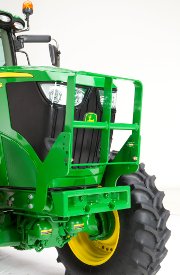 Hood guard on 6R Tractor
Hood guard on 6R Tractor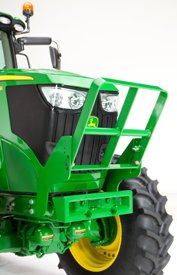 Hood guard for 6R folded down
Hood guard for 6R folded downThe hood guard's basic function is to:
- Help protect the tractor grille and hood from falling debris or stationary objects such as a wagon or mixer
- Allow for lighting at night
Compatibility:
- Can be used with or without the tractor front weight bracket but not with the actual front weights while using the loader (this would overload the front axle)
- Cannot be used with a front hitch
It is highly recommended to purchase a front weight bracket when using a loader. The hood guard is designed to be slightly rearward of the front weight bracket. This is so the front weight bracket is the first point of contact against lower stationary objects. The height of the hood guard allows better protection for the top of the hood and allows operators to see the top of the hood guard.
Hoses And Parts
3-Function SLC, M-ICV, Hoses and Parts - BWA1585
Hoses and parts (3-function) - BW15845
Hydraulic Connections
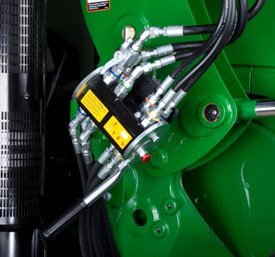 Single-point hydraulic connection on row crop tractor
Single-point hydraulic connection on row crop tractor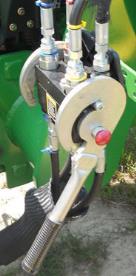 Single-point hydraulic connection on 5E Series Tractor
Single-point hydraulic connection on 5E Series Tractor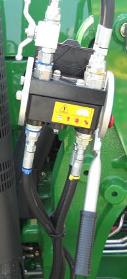 Single-point hydraulic connection on 5M Series Tractor
Single-point hydraulic connection on 5M Series Tractor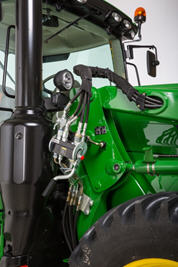 Single-point hydraulic connection with rigid lines on FT4 6R large frame
Single-point hydraulic connection with rigid lines on FT4 6R large frameThe H240, H260, H310, H340, and H360 Loaders feature a single-point hydraulic connection that also incorporates the connection point for any electrical needs as well. To disconnect the hydraulic connection between the loader and the tractor, it is necessary to relieve the hydraulic system oil pressure on the tractor.
To view a video of removing the single point hydraulic connection, click here.
Kit, 3rd Function Quick Coupler Parts - BW16133
Hydraulic Controls
LOADER SUSPENSION SYSTEM
 Nitrogen-charged accumulator and electric valve
Nitrogen-charged accumulator and electric valve Operator on/off switch
Operator on/off switch LSS on H180
LSS on H180 LSS on 5E and 5M
LSS on 5E and 5MAn enhancement to the loader is the suspension system. A great level of loader productivity is achieved with the LSS.
- An accumulator charged with nitrogen and connected to the head-end lift cylinder hose through a T-fitting provides shock absorption
- The cylinders move in and out to allow the boom to float
Performance
- Bales can be transported more efficiently from one end of the field to the other over frozen, hard-packed, or rutted terrain.
NOTE: Check bale-handling capability of tractor before use.
- Pallets can be moved easily without sustaining cargo damage
- Pallets of seed or fertilizer can be carried across a yard without a bag spilling and creating a costly mess
- A properly-ballasted tractor with LSS has increased stability, creating a smoother ride for the operator
Cost of ownership
- Extended life of loader pins and bushings
- Less stress on tractor axle
Reasons for turning LSS off include:
- Digging applications - with LSS on, the cylinders retract slightly, losing lifting power
- Holding a grade when blading - with LSS on, it is difficult to hold a constant grade
- Precise pallet and bale handling - with LSS on, the load moves up and down slightly while being positioned
- Parking a loader - with LSS on, when down pressure is applied, the lift cylinders retract slightly, making it more difficult to park
The switch is conveniently located in the operator station to avoid having to exit the tractor seat to manually move the handle on the LSS.
LSS can also be ordered with a manual shutoff. Depending on the tractor/loader model, the accumulator is located in different places. On the 440R, the accumulator is mounted outside the bottom of the mounting frame. On the 5 Series Tractors, the accumulator is mounted near the inside of the rear right wheel. On 6 Series tractors and larger, it is mounted in between the hydraulic connection and the mounting frame.
Loader Mounted Fenders
 Stationary fender (H480 shown)
Stationary fender (H480 shown)
Loader stationary fenders are highly recommended for those operating in conditions where the front axle will be in full oscillation and turn frequently or where tight turns are made while maneuvering through gates or obstacles that will catch tractor axle-mounted fenders.
The loader stationary fenders still provide coverage for debris from the tire, but they do not protrude to become damaged in operation. The fenders can be removed to enable better access for servicing as well.
Loader Suspension System
 Nitrogen-charged accumulator and electric valve
Nitrogen-charged accumulator and electric valve Operator on/off switch
Operator on/off switch LSS on H180
LSS on H180 LSS on 5E and 5M
LSS on 5E and 5MAn enhancement to the loader is the suspension system. A great level of loader productivity is achieved with the LSS.
- An accumulator charged with nitrogen and connected to the head-end lift cylinder hose through a T-fitting provides shock absorption
- The cylinders move in and out to allow the boom to float
Performance
- Bales can be transported more efficiently from one end of the field to the other over frozen, hard-packed, or rutted terrain.
NOTE: Check bale-handling capability of tractor before use.
- Pallets can be moved easily without sustaining cargo damage
- Pallets of seed or fertilizer can be carried across a yard without a bag spilling and creating a costly mess
- A properly-ballasted tractor with LSS has increased stability, creating a smoother ride for the operator
Cost of ownership
- Extended life of loader pins and bushings
- Less stress on tractor axle
Reasons for turning LSS off include:
- Digging applications - with LSS on, the cylinders retract slightly, losing lifting power
- Holding a grade when blading - with LSS on, it is difficult to hold a constant grade
- Precise pallet and bale handling - with LSS on, the load moves up and down slightly while being positioned
- Parking a loader - with LSS on, when down pressure is applied, the lift cylinders retract slightly, making it more difficult to park
The switch is conveniently located in the operator station to avoid having to exit the tractor seat to manually move the handle on the LSS.
LSS can also be ordered with a manual shutoff. Depending on the tractor/loader model, the accumulator is located in different places. On the 440R, the accumulator is mounted outside the bottom of the mounting frame. On the 5 Series Tractors, the accumulator is mounted near the inside of the rear right wheel. On 6 Series tractors and larger, it is mounted in between the hydraulic connection and the mounting frame.
 Nitrogen-charged accumulator and electric valve
Nitrogen-charged accumulator and electric valve Operator on/off switch
Operator on/off switch LSS on H180
LSS on H180 LSS on 5E and 5M
LSS on 5E and 5MAn enhancement to the loader is the suspension system. A great level of loader productivity is achieved with the LSS.
- An accumulator charged with nitrogen and connected to the head-end lift cylinder hose through a T-fitting provides shock absorption
- The cylinders move in and out to allow the boom to float
Performance
- Bales can be transported more efficiently from one end of the field to the other over frozen, hard-packed, or rutted terrain.
NOTE: Check bale-handling capability of tractor before use.
- Pallets can be moved easily without sustaining cargo damage
- Pallets of seed or fertilizer can be carried across a yard without a bag spilling and creating a costly mess
- A properly-ballasted tractor with LSS has increased stability, creating a smoother ride for the operator
Cost of ownership
- Extended life of loader pins and bushings
- Less stress on tractor axle
Reasons for turning LSS off include:
- Digging applications - with LSS on, the cylinders retract slightly, losing lifting power
- Holding a grade when blading - with LSS on, it is difficult to hold a constant grade
- Precise pallet and bale handling - with LSS on, the load moves up and down slightly while being positioned
- Parking a loader - with LSS on, when down pressure is applied, the lift cylinders retract slightly, making it more difficult to park
The switch is conveniently located in the operator station to avoid having to exit the tractor seat to manually move the handle on the LSS.
LSS can also be ordered with a manual shutoff. Depending on the tractor/loader model, the accumulator is located in different places. On the 440R, the accumulator is mounted outside the bottom of the mounting frame. On the 5 Series Tractors, the accumulator is mounted near the inside of the rear right wheel. On 6 Series tractors and larger, it is mounted in between the hydraulic connection and the mounting frame.
 Nitrogen-charged accumulator and electric valve
Nitrogen-charged accumulator and electric valve Operator on/off switch
Operator on/off switch LSS on H180
LSS on H180 LSS on 5E and 5M
LSS on 5E and 5MAn enhancement to the loader is the suspension system. A great level of loader productivity is achieved with the LSS.
- An accumulator charged with nitrogen and connected to the head-end lift cylinder hose through a T-fitting provides shock absorption
- The cylinders move in and out to allow the boom to float
Performance
- Bales can be transported more efficiently from one end of the field to the other over frozen, hard-packed, or rutted terrain.
NOTE: Check bale-handling capability of tractor before use.
- Pallets can be moved easily without sustaining cargo damage
- Pallets of seed or fertilizer can be carried across a yard without a bag spilling and creating a costly mess
- A properly-ballasted tractor with LSS has increased stability, creating a smoother ride for the operator
Cost of ownership
- Extended life of loader pins and bushings
- Less stress on tractor axle
Reasons for turning LSS off include:
- Digging applications - with LSS on, the cylinders retract slightly, losing lifting power
- Holding a grade when blading - with LSS on, it is difficult to hold a constant grade
- Precise pallet and bale handling - with LSS on, the load moves up and down slightly while being positioned
- Parking a loader - with LSS on, when down pressure is applied, the lift cylinders retract slightly, making it more difficult to park
The switch is conveniently located in the operator station to avoid having to exit the tractor seat to manually move the handle on the LSS.
LSS can also be ordered with a manual shutoff. Depending on the tractor/loader model, the accumulator is located in different places. On the 440R, the accumulator is mounted outside the bottom of the mounting frame. On the 5 Series Tractors, the accumulator is mounted near the inside of the rear right wheel. On 6 Series tractors and larger, it is mounted in between the hydraulic connection and the mounting frame.
 Nitrogen-charged accumulator and electric valve
Nitrogen-charged accumulator and electric valve Operator on/off switch
Operator on/off switch LSS on H180
LSS on H180 LSS on 5E and 5M
LSS on 5E and 5MAn enhancement to the loader is the suspension system. A great level of loader productivity is achieved with the LSS.
- An accumulator charged with nitrogen and connected to the head-end lift cylinder hose through a T-fitting provides shock absorption
- The cylinders move in and out to allow the boom to float
Performance
- Bales can be transported more efficiently from one end of the field to the other over frozen, hard-packed, or rutted terrain.
NOTE: Check bale-handling capability of tractor before use.
- Pallets can be moved easily without sustaining cargo damage
- Pallets of seed or fertilizer can be carried across a yard without a bag spilling and creating a costly mess
- A properly-ballasted tractor with LSS has increased stability, creating a smoother ride for the operator
Cost of ownership
- Extended life of loader pins and bushings
- Less stress on tractor axle
Reasons for turning LSS off include:
- Digging applications - with LSS on, the cylinders retract slightly, losing lifting power
- Holding a grade when blading - with LSS on, it is difficult to hold a constant grade
- Precise pallet and bale handling - with LSS on, the load moves up and down slightly while being positioned
- Parking a loader - with LSS on, when down pressure is applied, the lift cylinders retract slightly, making it more difficult to park
The switch is conveniently located in the operator station to avoid having to exit the tractor seat to manually move the handle on the LSS.
LSS can also be ordered with a manual shutoff. Depending on the tractor/loader model, the accumulator is located in different places. On the 440R, the accumulator is mounted outside the bottom of the mounting frame. On the 5 Series Tractors, the accumulator is mounted near the inside of the rear right wheel. On 6 Series tractors and larger, it is mounted in between the hydraulic connection and the mounting frame.
 Nitrogen-charged accumulator and electric valve
Nitrogen-charged accumulator and electric valve Operator on/off switch
Operator on/off switch LSS on H180
LSS on H180 LSS on 5E and 5M
LSS on 5E and 5MAn enhancement to the loader is the suspension system. A great level of loader productivity is achieved with the LSS.
- An accumulator charged with nitrogen and connected to the head-end lift cylinder hose through a T-fitting provides shock absorption
- The cylinders move in and out to allow the boom to float
Performance
- Bales can be transported more efficiently from one end of the field to the other over frozen, hard-packed, or rutted terrain.
NOTE: Check bale-handling capability of tractor before use.
- Pallets can be moved easily without sustaining cargo damage
- Pallets of seed or fertilizer can be carried across a yard without a bag spilling and creating a costly mess
- A properly-ballasted tractor with LSS has increased stability, creating a smoother ride for the operator
Cost of ownership
- Extended life of loader pins and bushings
- Less stress on tractor axle
Reasons for turning LSS off include:
- Digging applications - with LSS on, the cylinders retract slightly, losing lifting power
- Holding a grade when blading - with LSS on, it is difficult to hold a constant grade
- Precise pallet and bale handling - with LSS on, the load moves up and down slightly while being positioned
- Parking a loader - with LSS on, when down pressure is applied, the lift cylinders retract slightly, making it more difficult to park
The switch is conveniently located in the operator station to avoid having to exit the tractor seat to manually move the handle on the LSS.
LSS can also be ordered with a manual shutoff. Depending on the tractor/loader model, the accumulator is located in different places. On the 440R, the accumulator is mounted outside the bottom of the mounting frame. On the 5 Series Tractors, the accumulator is mounted near the inside of the rear right wheel. On 6 Series tractors and larger, it is mounted in between the hydraulic connection and the mounting frame.
Miscellaneous
The loader hoses are connected to the mid-tractor selective control valves (SCVs).
Two function
 Two function quick coupler
Two function quick coupler
The H240, H260, H310, H340, and H360 Loaders feature two-function quick-couplers in base machine. To disconnect the hydraulic connection between the loader and the tractor, it is necessary to relieve the hydraulic system oil pressure on the tractor.
To watch a video of how to use quick couplers click here.
NOTE: this video is intended to show the functionality of quick couplers only. Location of the connection varies across different loaders.
Three function
 Three function quick coupler
Three function quick couplerThe H240, H260, H310, H340, and H360 Loaders can be equipped with three-function quick-couplers. Hoses will be installed in the boom arm and just the couplers will need to be assembled along with the third-function bracket and oil line. To disconnect the hydraulic connection between the loader and the tractor, it is necessary to relieve the hydraulic system oil pressure on the tractor.
2-Function SLC, M-ICV, Hoses and Parts - BWA1510
The loader hoses are connected to the mid-tractor selective control valves (SCVs).
The loader hoses are connected to the mid-tractor selective control valves (SCVs).
2-Function Single Lever Control, M-ICV, Hoses and Parts for Field Installation - BWA1575
 Single-point hydraulic connection on row crop tractor
Single-point hydraulic connection on row crop tractor Single-point hydraulic connection on 5E Series Tractor
Single-point hydraulic connection on 5E Series Tractor Single-point hydraulic connection on 5M Series Tractor
Single-point hydraulic connection on 5M Series Tractor Single-point hydraulic connection with rigid lines on FT4 6R large frame
Single-point hydraulic connection with rigid lines on FT4 6R large frameThe H240, H260, H310, H340, and H360 Loaders feature a single-point hydraulic connection that also incorporates the connection point for any electrical needs as well. To disconnect the hydraulic connection between the loader and the tractor, it is necessary to relieve the hydraulic system oil pressure on the tractor.
To view a video of removing the single point hydraulic connection, click here.
The loader hoses are connected to the mid-tractor selective control valves (SCVs).
The loader hoses are connected to the mid-tractor selective control valves (SCVs).
 Single-point hydraulic connection on row crop tractor
Single-point hydraulic connection on row crop tractor Single-point hydraulic connection on 5E Series Tractor
Single-point hydraulic connection on 5E Series Tractor Single-point hydraulic connection on 5M Series Tractor
Single-point hydraulic connection on 5M Series Tractor Single-point hydraulic connection with rigid lines on FT4 6R large frame
Single-point hydraulic connection with rigid lines on FT4 6R large frameThe H240, H260, H310, H340, and H360 Loaders feature a single-point hydraulic connection that also incorporates the connection point for any electrical needs as well. To disconnect the hydraulic connection between the loader and the tractor, it is necessary to relieve the hydraulic system oil pressure on the tractor.
To view a video of removing the single point hydraulic connection, click here.
 Single-point hydraulic connection on row crop tractor
Single-point hydraulic connection on row crop tractor Single-point hydraulic connection on 5E Series Tractor
Single-point hydraulic connection on 5E Series Tractor Single-point hydraulic connection on 5M Series Tractor
Single-point hydraulic connection on 5M Series Tractor Single-point hydraulic connection with rigid lines on FT4 6R large frame
Single-point hydraulic connection with rigid lines on FT4 6R large frameThe H240, H260, H310, H340, and H360 Loaders feature a single-point hydraulic connection that also incorporates the connection point for any electrical needs as well. To disconnect the hydraulic connection between the loader and the tractor, it is necessary to relieve the hydraulic system oil pressure on the tractor.
To view a video of removing the single point hydraulic connection, click here.
 Single-point hydraulic connection on row crop tractor
Single-point hydraulic connection on row crop tractor Single-point hydraulic connection on 5E Series Tractor
Single-point hydraulic connection on 5E Series Tractor Single-point hydraulic connection on 5M Series Tractor
Single-point hydraulic connection on 5M Series Tractor Single-point hydraulic connection with rigid lines on FT4 6R large frame
Single-point hydraulic connection with rigid lines on FT4 6R large frameThe H240, H260, H310, H340, and H360 Loaders feature a single-point hydraulic connection that also incorporates the connection point for any electrical needs as well. To disconnect the hydraulic connection between the loader and the tractor, it is necessary to relieve the hydraulic system oil pressure on the tractor.
To view a video of removing the single point hydraulic connection, click here.
 Replaceable wear edge
Replaceable wear edge
For those who frequently scrape on concrete, a replaceable cutting edge will greatly extend the life of the bucket:
- 1850-mm (73-in.) width replaceable cutting edge
- 2150-mm (85-in.) width replaceable cutting edge
- 2450-mm (96-in.) width replaceable cutting edge
- 2750-mm (108-in.) width replaceable cutting edge
The loader hoses are connected to the mid-tractor selective control valves (SCVs).
3 Function Single Point Hydraulic Connection (tractor and loader half) - BW16960
The loader hoses are connected to the mid-tractor selective control valves (SCVs).
3-Function Hydraulic Hoses and Parts - BWA1590
3-Function Hydraulic Hoses and Parts - BWA1591
3-Function Hydraulic Hoses and Parts - BWA1614
3-Function Hydraulic Hoses and Parts - BWA1615
Two function
 Two function quick coupler
Two function quick coupler
The H240, H260, H310, H340, and H360 Loaders feature two-function quick-couplers in base machine. To disconnect the hydraulic connection between the loader and the tractor, it is necessary to relieve the hydraulic system oil pressure on the tractor.
To watch a video of how to use quick couplers click here.
NOTE: this video is intended to show the functionality of quick couplers only. Location of the connection varies across different loaders.
Three function
 Three function quick coupler
Three function quick couplerThe H240, H260, H310, H340, and H360 Loaders can be equipped with three-function quick-couplers. Hoses will be installed in the boom arm and just the couplers will need to be assembled along with the third-function bracket and oil line. To disconnect the hydraulic connection between the loader and the tractor, it is necessary to relieve the hydraulic system oil pressure on the tractor.
3-Function Quick Couplers - BW16958
The loader hoses are connected to the mid-tractor selective control valves (SCVs).
The loader hoses are connected to the mid-tractor selective control valves (SCVs).
The loader hoses are connected to the mid-tractor selective control valves (SCVs).
3-Function Single Lever Control, M-ICV, Hoses and Parts for Field Installation - BWA1576
 Single-point hydraulic connection on row crop tractor
Single-point hydraulic connection on row crop tractor Single-point hydraulic connection on 5E Series Tractor
Single-point hydraulic connection on 5E Series Tractor Single-point hydraulic connection on 5M Series Tractor
Single-point hydraulic connection on 5M Series Tractor Single-point hydraulic connection with rigid lines on FT4 6R large frame
Single-point hydraulic connection with rigid lines on FT4 6R large frameThe H240, H260, H310, H340, and H360 Loaders feature a single-point hydraulic connection that also incorporates the connection point for any electrical needs as well. To disconnect the hydraulic connection between the loader and the tractor, it is necessary to relieve the hydraulic system oil pressure on the tractor.
To view a video of removing the single point hydraulic connection, click here.
3-function multi-coupler - BW16402
3-function multi-coupler, loader half - BW16401
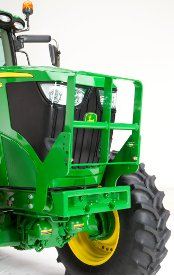 Hood guard on 6R Tractor
Hood guard on 6R Tractor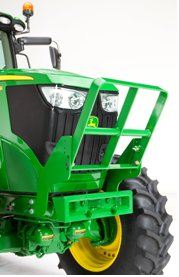 Hood guard for 6R folded down
Hood guard for 6R folded downThe hood guard's basic function is to:
- Help protect the tractor grille and hood from falling debris or stationary objects such as a wagon or mixer
- Allow for lighting at night
Compatibility:
- Can be used with or without the tractor front weight bracket but not with the actual front weights while using the loader (this would overload the front axle)
- Cannot be used with a front hitch
It is highly recommended to purchase a front weight bracket when using a loader. The hood guard is designed to be slightly rearward of the front weight bracket. This is so the front weight bracket is the first point of contact against lower stationary objects. The height of the hood guard allows better protection for the top of the hood and allows operators to see the top of the hood guard.
 Hood guard for 5M Series Tractors
Hood guard for 5M Series Tractors Hood guard for 6D Series Tractors
Hood guard for 6D Series TractorsThe heavy-duty hood guard is compatible with 5M (5065M, 5075M, 5085M, 5095M, 5100M, 5105M, and 5115M), 6D – model year 2012 and prior (6100D, 6115D, 6130D, and 6140D), 6D – Interim Tier 4 (IT4) model years 2013 -2015 (6105D, 6115D, 6130D, and 6140D), and 6E Final Tier 4 (FT4) model year 2016 (6105E, 6120E, and 6135E) Tractors.
The basic function of a hood guard is to:
- Help protect the tractor grille and hood from falling debris or stationary objects such as a wagon or mixer
- Allow for lighting at night
The hood guard:
- Can be used with or without the tractor front weight bracket but not with the actual front weights while using the loader (this would overload the front axle)
- For the 5M Series Tractors, the bottom bar must be removed for usage with front hitch for storage position of the center link.
It is highly recommended to purchase a front weight bracket when using a loader. The hood guard is designed to be slightly rearward of the front weight bracket. This is so the front weight bracket is the first point of contact against lower stationary objects.
If a front weight bracket is not used, the lower bar can be moved downward to improve the protection of the grille below the lights.
The features of the hood guard include:
- Folds down to allow the hood to open and provide access to the battery and filter
- Extra steel behind the mainframe to increase strength
- High height to better protect the top of the hood
The loader hoses are connected to the mid-tractor selective control valves (SCVs).
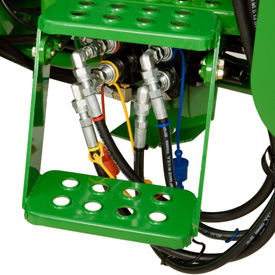 2-function hoses and couplers
2-function hoses and couplersHoses and parts (2-function) - BW15844
The loader hoses are connected to the mid-tractor selective control valves (SCVs).
Hoses and parts (3-function) - BW16069
Hoses and parts (3-function) - BW16103
Hoses and parts (3-function) - BW16187
Kit, 3-function single-point connection parts - BW16132
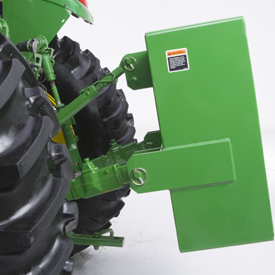
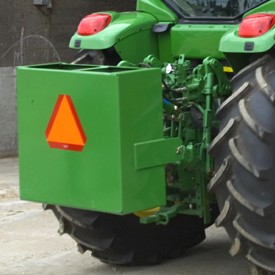
Large ballast box is available to carry additional ballast for greater tractor stability.
Capacities | |||
Weight | Sand (Dry) | Concrete | Portland Cement |
BW15852 Large ballast box: | |||
| Volume | 13.3 ft3 = 377L | ||
Material | 581 kg (1277 lb) | 871 kg (1915 lb) | 1089 kg (2395 lb) |
Empty box | 155 kg (342 lb) | 155 kg (342 lb) | 155 kg (342 lb) |
Total | 736 kg (1619 lb) | 1026 kg (2257 lb) | 1244 kg (2737 lb) |
BW15852 Large ballast box is compatible with Category 2 Quik-Couplers and Category 2 or 3 hitches.
See ''Rear Ballast Requirements'' for proper ballasting of the tractor.
Mid-mounted independent control valve (2-function) - BW15985
Mid-mounted independent control valve (3-function) - BW15986
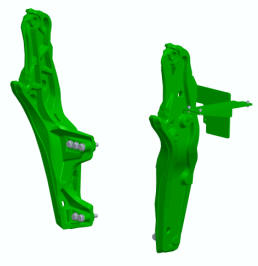 5M mounting frame
5M mounting frame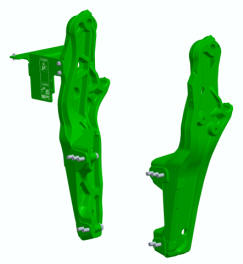 5M mounting frame
5M mounting frame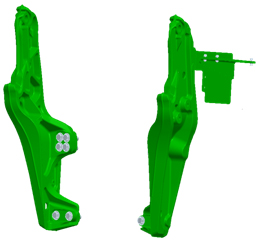 6E Final Tier 4 (FT4) and 6D Interim Tier 4 (IT4) (model year 2013-2015) mounting frame
6E Final Tier 4 (FT4) and 6D Interim Tier 4 (IT4) (model year 2013-2015) mounting frame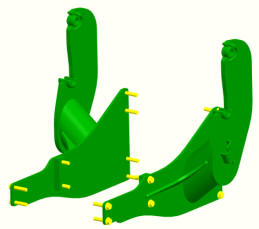 6D (model year 2012 and prior) mounting frame
6D (model year 2012 and prior) mounting frame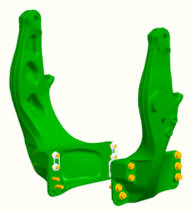 6M (small chassis), 6R (small chassis), 6030, 6030 Premium, 6020, 6010, and 6000 Series Tractors mounting frame
6M (small chassis), 6R (small chassis), 6030, 6030 Premium, 6020, 6010, and 6000 Series Tractors mounting frame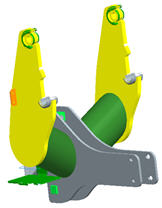 5E 4 Cylinder (IT4; 5085E, 5100E) mounting frame
5E 4 Cylinder (IT4; 5085E, 5100E) mounting frameMounting frames are designed to evenly distribute forces during loader operation. Hardware is accessible to torque to the correct specifications.
 5M mounting frame
5M mounting frame 5M mounting frame
5M mounting frame 6E Final Tier 4 (FT4) and 6D Interim Tier 4 (IT4) (model year 2013-2015) mounting frame
6E Final Tier 4 (FT4) and 6D Interim Tier 4 (IT4) (model year 2013-2015) mounting frame 6D (model year 2012 and prior) mounting frame
6D (model year 2012 and prior) mounting frame 6M (small chassis), 6R (small chassis), 6030, 6030 Premium, 6020, 6010, and 6000 Series Tractors mounting frame
6M (small chassis), 6R (small chassis), 6030, 6030 Premium, 6020, 6010, and 6000 Series Tractors mounting frame 5E 4 Cylinder (IT4; 5085E, 5100E) mounting frame
5E 4 Cylinder (IT4; 5085E, 5100E) mounting frameMounting frames are designed to evenly distribute forces during loader operation. Hardware is accessible to torque to the correct specifications.
 5M mounting frame
5M mounting frame 5M mounting frame
5M mounting frame 6E Final Tier 4 (FT4) and 6D Interim Tier 4 (IT4) (model year 2013-2015) mounting frame
6E Final Tier 4 (FT4) and 6D Interim Tier 4 (IT4) (model year 2013-2015) mounting frame 6D (model year 2012 and prior) mounting frame
6D (model year 2012 and prior) mounting frame 6M (small chassis), 6R (small chassis), 6030, 6030 Premium, 6020, 6010, and 6000 Series Tractors mounting frame
6M (small chassis), 6R (small chassis), 6030, 6030 Premium, 6020, 6010, and 6000 Series Tractors mounting frame 5E 4 Cylinder (IT4; 5085E, 5100E) mounting frame
5E 4 Cylinder (IT4; 5085E, 5100E) mounting frameMounting frames are designed to evenly distribute forces during loader operation. Hardware is accessible to torque to the correct specifications.
Mounting frame - BW16087
Power Beyond spacer - BW15989
Single-level control and valve (2-function) - BW15773
Single-level control and valve (3-function) - BW15774
Single-lever control and mounting parts 3-function with Global Strategic Supplier (GSS) - BW15785
Single-lever control and mounting parts 3-function with Global Strategic Supplier (GSS) - BW15807
Tool box bracket - BW16126
Tool box bracket - BW15971
Miscellaneous
Mounting Frames
 5M mounting frame
5M mounting frame 5M mounting frame
5M mounting frame 6E Final Tier 4 (FT4) and 6D Interim Tier 4 (IT4) (model year 2013-2015) mounting frame
6E Final Tier 4 (FT4) and 6D Interim Tier 4 (IT4) (model year 2013-2015) mounting frame 6D (model year 2012 and prior) mounting frame
6D (model year 2012 and prior) mounting frame 6M (small chassis), 6R (small chassis), 6030, 6030 Premium, 6020, 6010, and 6000 Series Tractors mounting frame
6M (small chassis), 6R (small chassis), 6030, 6030 Premium, 6020, 6010, and 6000 Series Tractors mounting frame 5E 4 Cylinder (IT4; 5085E, 5100E) mounting frame
5E 4 Cylinder (IT4; 5085E, 5100E) mounting frameMounting frames are designed to evenly distribute forces during loader operation. Hardware is accessible to torque to the correct specifications.






